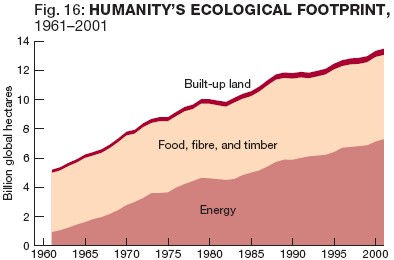 As I stepped outside yesterday into a balmy 59 degrees (one degree shy of a 22 year old record), I couldn’t help but think about the recent barrage of news related to global warming and the ensuing debates. Newsweek, BusinessWeek, the WSJ, etc., have all had feature articles on the subject over the past two weeks.
As I stepped outside yesterday into a balmy 59 degrees (one degree shy of a 22 year old record), I couldn’t help but think about the recent barrage of news related to global warming and the ensuing debates. Newsweek, BusinessWeek, the WSJ, etc., have all had feature articles on the subject over the past two weeks.
I believe global warming is real, and have a hard time buying the argument that the recent changes to Earth’s climate are solely due to natural climate shifts that would have happened anyway. Take, for example, the concept of an ecological footprint, a larger form of what is sometimes called a carbon or energy footprint. The best definition, according to Aili McConnon of BusinessWeek is that it’s “how much land and sea we need to generate the resources we consume and to absorb the waste we create.” Using the standard seven compenents – crop land, grazing land, forest, fishing ground, nuclear waste, built-up land, and CO2 emissions – humanity’s global footprint in 1961 was about 4.5 billion global hectares (GH). Latest estimates put that at 14.1 billion GH, and the World Wildlife Fund actually claims it could be more. As you’ll see from the chart in the upper right, almost half of that comes from energy-related activities.
14.1 billion GH may seem like an arbitrary number, but it equates to roughly 2.2 GH, or about four football fields, per person. I’m having a hard time believing I’m using up that much of Earth’s space and resources, but some of the footprint calculators reveal that I may be even fatter than the international average, despite my energy efficient car and relatively small living space.
It is well known that the United States has been slow to move toward alternative fuels due to regulatory, technological, and economic pressures, and even a Democratic Congress may have a hard time accelerating the adoption. So, what can I do about it? As the largest portion of the footprint comes from our daily energy activities, many analysts have advised contributing to energy research in some fashion, whether through buying stock in alternative fuel companies, contributing dollars directly, or buying an alternative fuel vehicle. I wonder what the power of those dollars would be on the aggregate, and if increased cash flow would lead to increased alternative energy options given the other non-cash hurdles (and dis-incentives) in the industry?
Actually, I think the Dems have a decent shot at passing renewable energy (to be distinguished from alternative energy) incentives because the Bush Administration supports tax credits, etc for R&D and production. The Dems could run into trouble if they attach it to other stuff, but as a stand-alone, alt and renewable energy incentives are generally supported broadly. Congress just extended the production tax credit for a year and the GOP and Dems are trying to make the credit permanent. What Bush doesn’t support is legislation insituting mandatory emission controls, such as a cap-and-trade regime, on industry (particularly utilities).